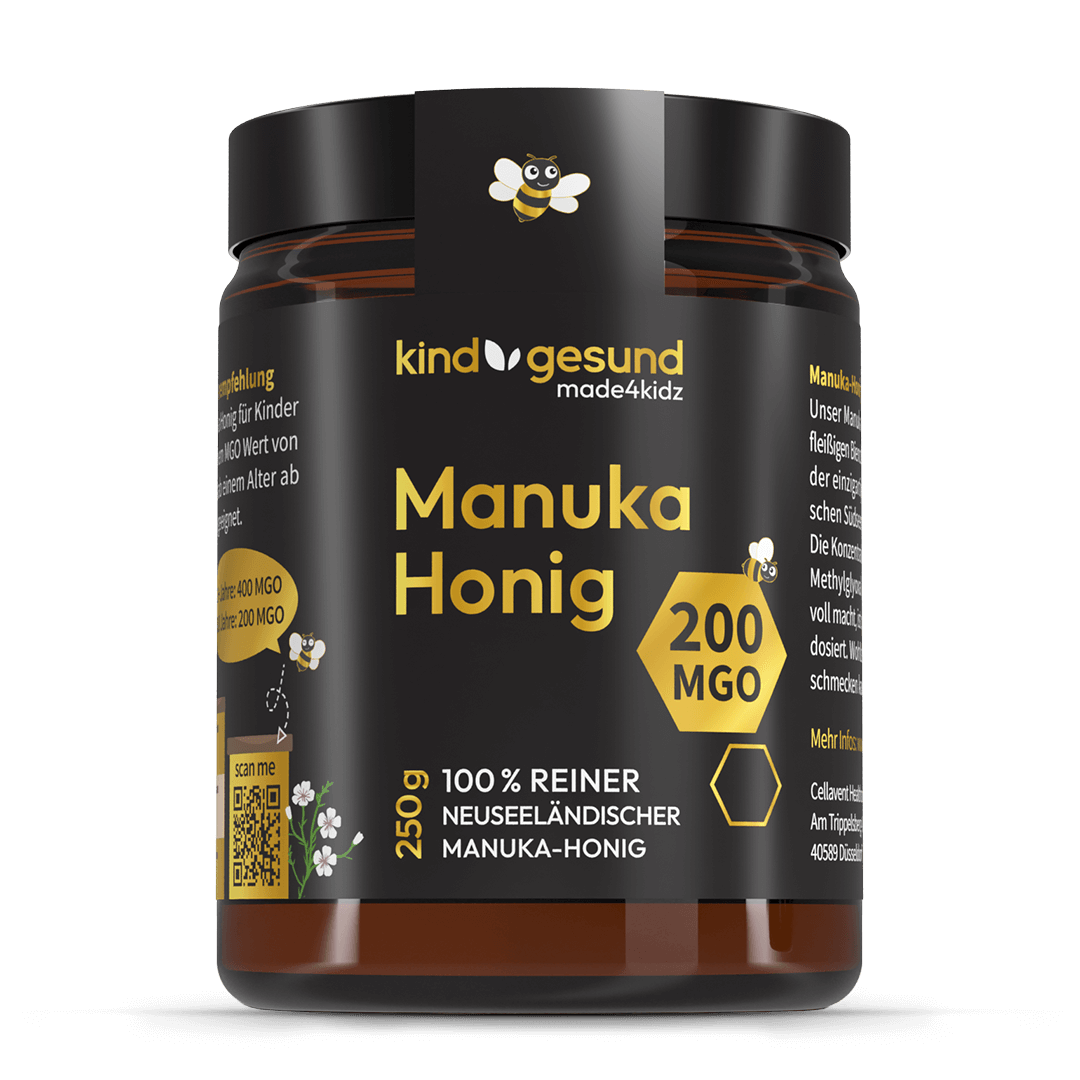
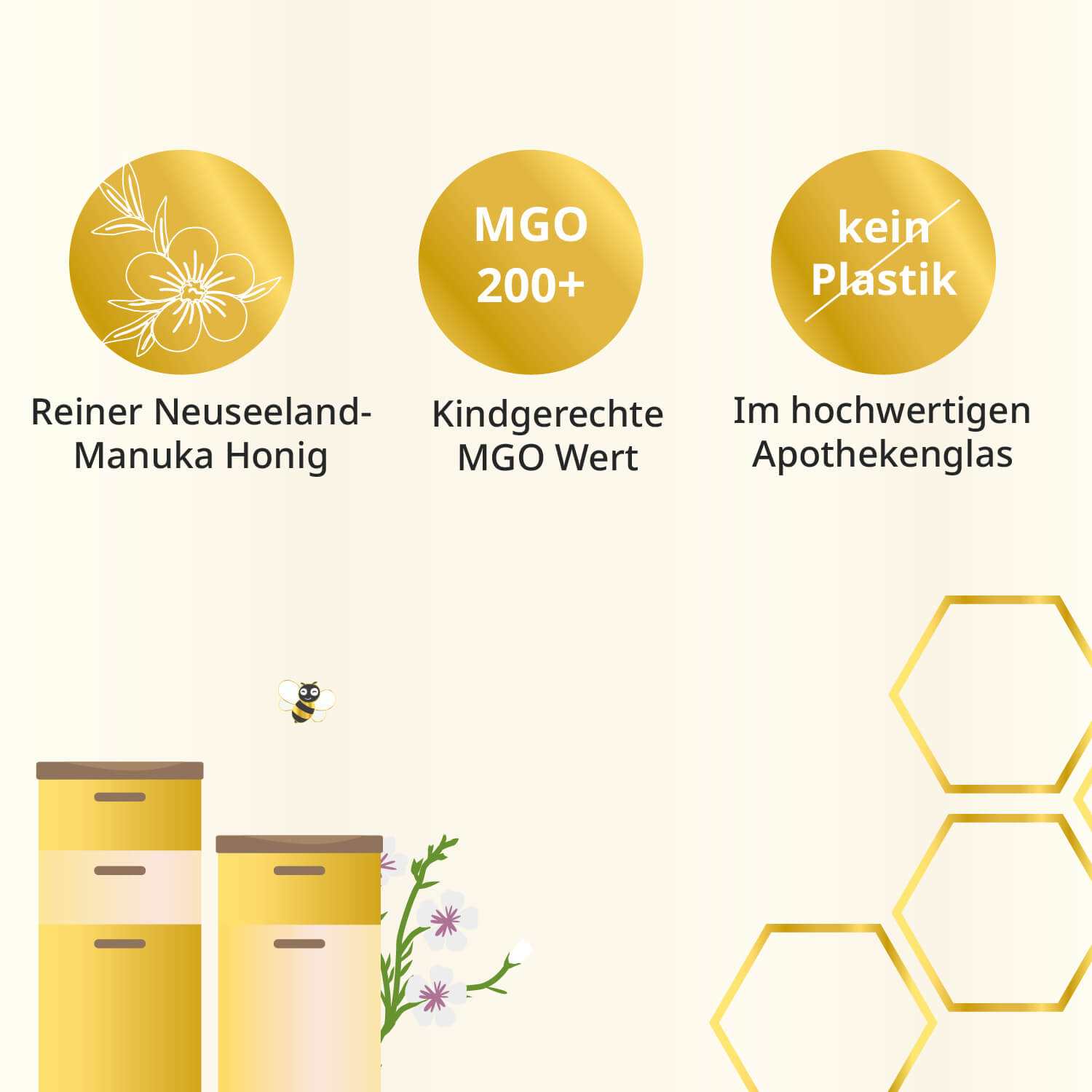
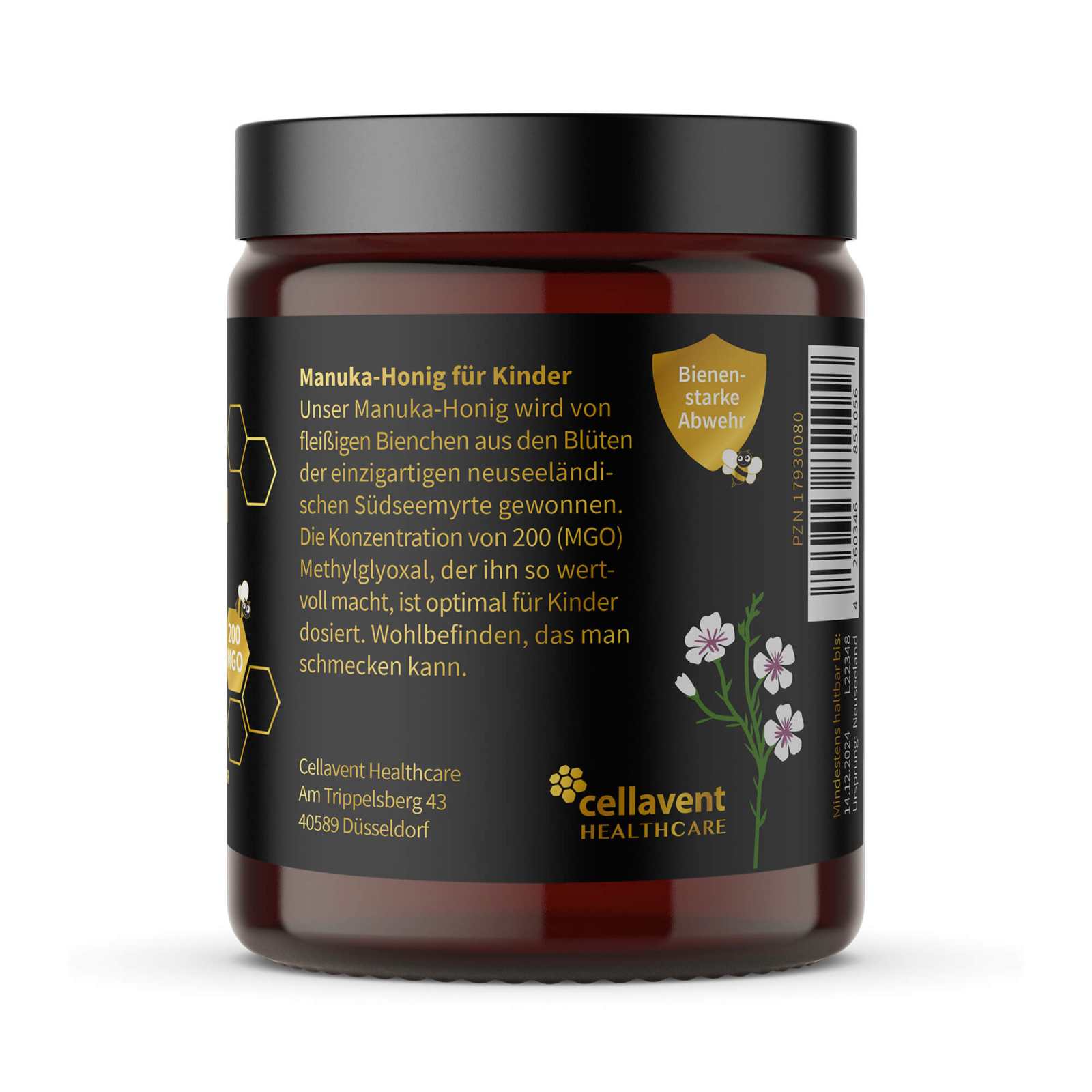
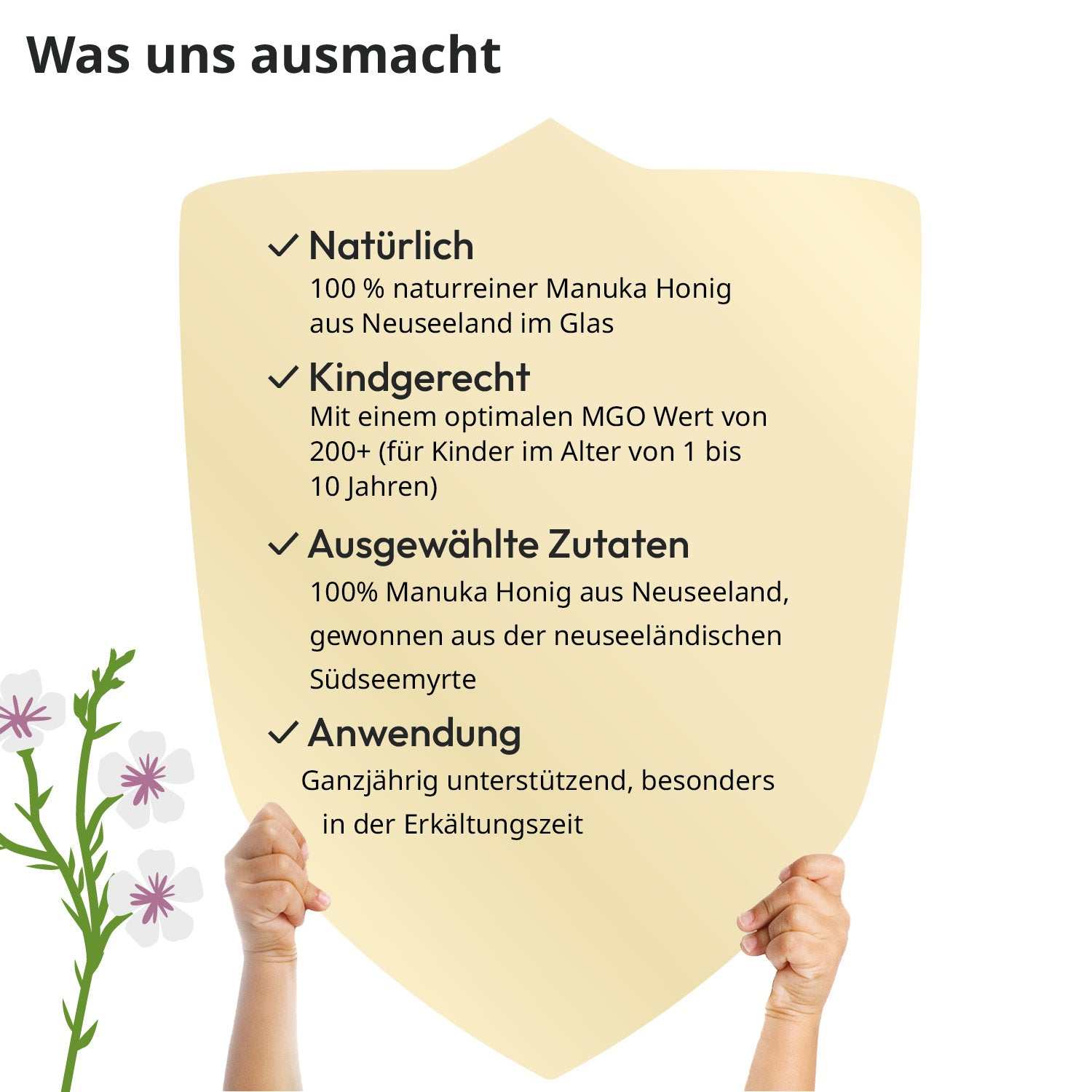
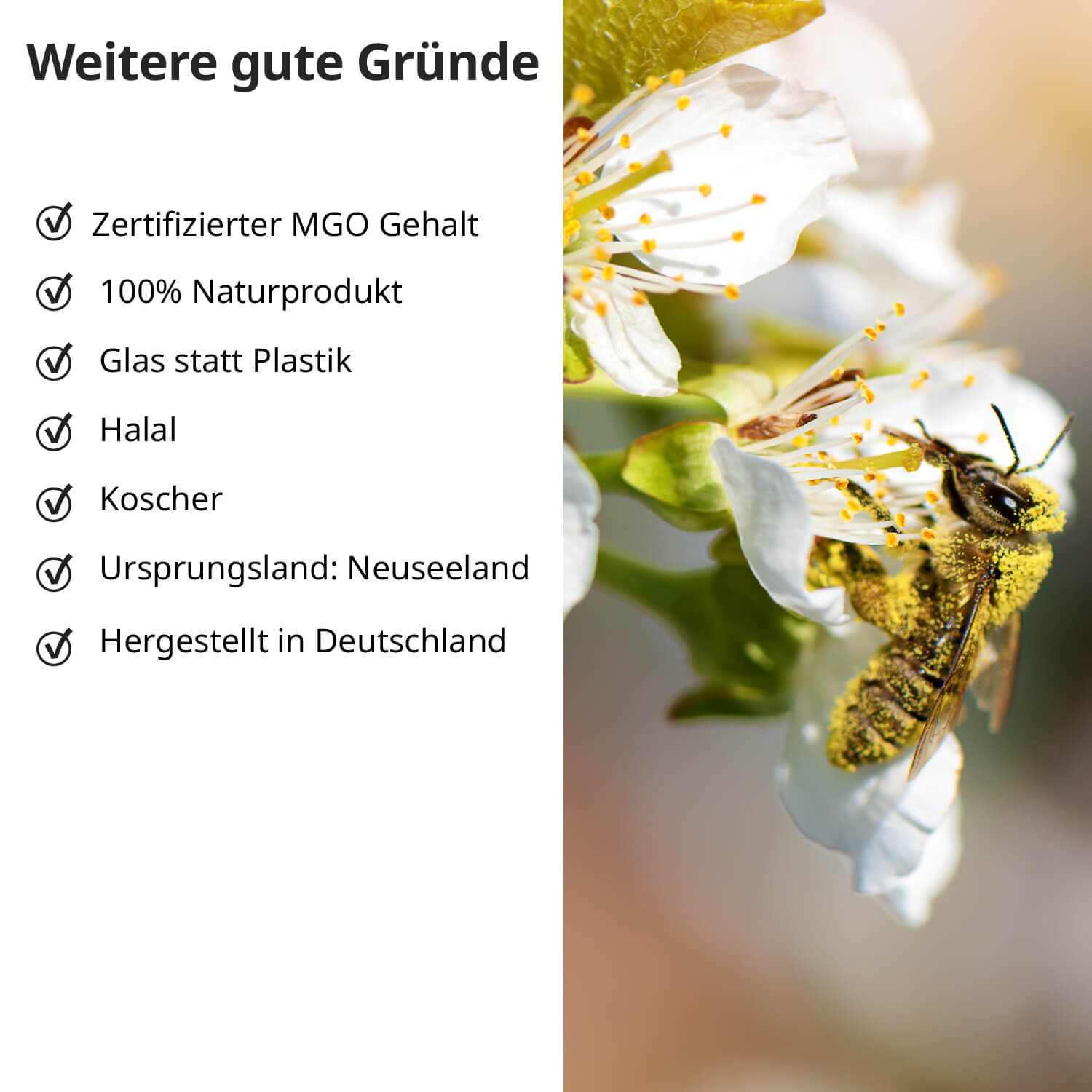
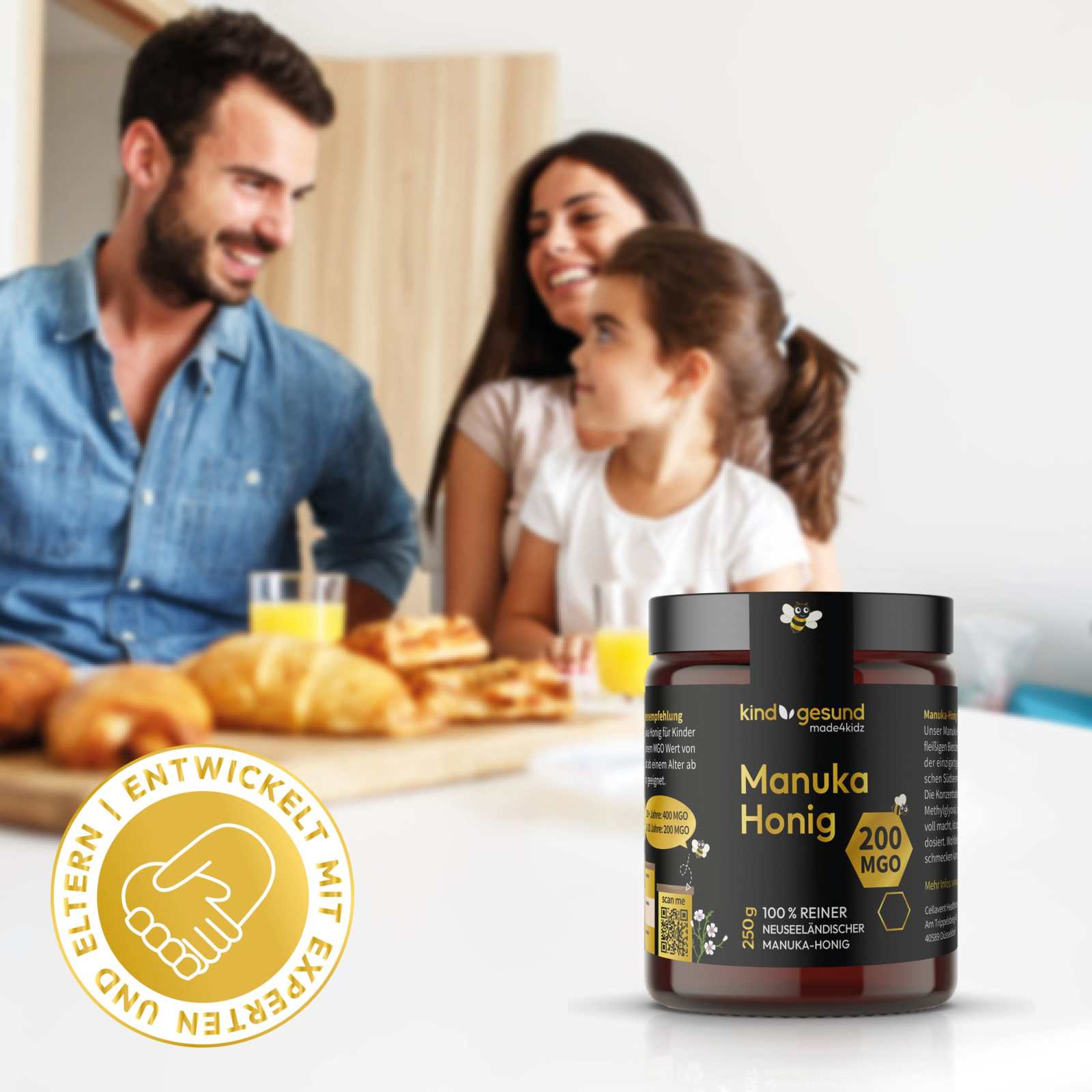
Manuka honey for children 200 MGO - kindgesund
• Verified origin (New Zealand)
• Guaranteed MGO of over 200+
• In high-quality apothecary glass, no plastic
• Year-round companion, especially during the cold autumn and winter seasons
The premium Manuka honey for children comes from the special New Zealand South Sea Myrtle, which was also used as a medicinal plant by the indigenous Maori.
The concentration of the natural Methylglyoxal (MGO) in the kindgesund Manuka honey has been optimally adjusted to meet children's needs.
Due to its versatile therapeutic benefits, kindgesund Manuka honey is one of the healthiest honeys on the market.
Its smell and taste are uniquely sweet and unlike conventional honeys.
The Manuka honey for children can be used both for preparing home remedies and for sweetening liquids and foods. We recommend taking 1–2 teaspoons daily, either pure or diluted (in maximum 40°C warm milk or tea).
All the benefits of our Manuka honey for children:
- 100% pure & aromatic
- Child-friendly dosage with 200 MGO
- Uniquely sweet taste
- Rich in polyphenols & flavonoids
- From the New Zealand South Sea Myrtle
- Packed in high-quality brown glass
PZN Number:
17930080
Content:
250 g of pure New Zealand Manuka honey
Recommended intake:
Take 1-2 teaspoons daily, either pure or diluted (in maximum 40°C warm milk or tea).
Ingredients:
100% Manuka honey
Storage:
Store in a cool, dry place protected from direct sunlight.
Note:
Honey is natural raw food and therefore not suitable for children under 12 months. Consumption is recommended only from the age of 1 year!
Tax included. Shipping calculated at checkout
- du deinem Kind eine natürliche Alternative ohne künstliche Zusätze bieten möchtest
- dir geprüfte Qualität und Herkunft bei Honig besonders wichtig sind
- dein Kind Honig liebt – sanft im Geschmack und vielseitig verwendbar
Delivery within Germany:
- Free shipping for orders over €29.
- Orders under €29: €4.95 postage.
International deliveries (except Switzerland):
- Free shipping for orders over 100 €.
- Orders under €100: €7.50 postage.
Delivery to Switzerland:
- Free shipping for orders over 200 €.
- Orders over €150: €7.50 postage.
- Orders under 150 €: 15 € postage.
For further details, please see our shipping conditions .
PZN (Pharmazentralnummer): 17930080
Hinweis:

Zutaten
Gutes beginnt mit den besten Inhaltsstoffen – deshalb stehen sie an erster Stelle
100% pure New Zealand Manuka honey
Zertifikat herunterladen
Inhaltsstoff
Warum ein Manuka Honig für Kinder?
Unsere kindgesund Manuka Honige zeichnen sich durch ihren besonders altersgerechten enthaltenen MGO-Anteil aus.
Sein Geruch und Geschmack sind einzigartig und nicht vergleichbar mit herkömmlichen Honigen. Die natürlich im Manuka Honig enthaltenen Polyphenole und Flavonoide machen unseren Kinder Manuka Honig zu etwas ganz Besonderem.
Aufgrund der vielzähligen positiven Eigenschaften kann Manuka Honig für die Zubereitung von Hausmitteln, als auch zum Süßen von Flüssigkeiten und Speisen angewendet werden.

Qualität
Woher kommt Manuka Honig?
Der besondere kindgesund Manuka Honig für Kinder stammt aus dem Nektar der seltenen Blüten neuseeländischer Südseemyrten, die auch von den einheimischen Maori einst als Heilpflanze eingesetzt wurde. Sie wachsen in naturbelassenen Bergregionen Neuseelands und können sich von kleinen Sträuchern zu bis zu 8 m hohen Bäumen entwickeln.
Unsere Bienenstöcke werden in der Nähe von blühenden Manuka-Pflanzen aufgestellt, damit die Bienen den Nektar sammeln und zu Honig verarbeiten können. Nach der Ernte wird der Honig extrahiert, gefiltert und auf seine Qualität geprüft, um sicherzustellen, dass er den erforderlichen Gehalt an Methylglyoxal (MGO) enthält.
Die Sicherheit und Herkunft unserer Manuka Honige wird selbstverständlich regelmäßig überprüft. Zum Prüfbericht

Wissenswertes
Was bedeutet MGO?
Die besondere Wirkung von Manuka-Honig wird maßgeblich durch den Methyglyoxal (MGO) Gehalt und seine Reinheit bestimmt. Der MGO-Wert gibt die Menge dieses Inhaltsstoffs in Milligramm pro Kilogramm an und dient als Qualitätsmaßstab für den Honig. Methyglyoxal kann auch in geringen Mengen in anderen Honigsorten vorkommen, doch je höher der Anteil im Honig ist, desto hochwertiger ist er.
Die MGO-Konzentration im kindgesund Manuka Honig wurde mit über 200+ optimal auf die Bedürfnisse von Kindern im Alter von 1-10 Jahren angepasst.
Ein gewöhnlicher Blütenhonig hat zum Vergleich einen MGO-Wert von 0 bis maximal 20, während Manuka Honige einen MGO-Wert von bis zu 1000+ erreichen kann.
FAQ - Die häufigsten Fragen
Ist Manuka Honig für Kinder geeignet?
Abhängig vom MGO-Gehalt, kann Manuka Honig schon ab dem 1. Lebensjahr von Kinder eingenommen werden. Er sollte jedoch wie bei jedem Honig wegen des Risikos von Botulismus Infektionen nicht an Säuglinge unter einem Jahr gegeben werden.
Bis zu einem MGO-Gehalt von 200 empfehlen wir den Verzehr im Alter von 1-10 Jahren. Ab einem MGO von über 400 ist er ab 10 bis 14 Jahren geeignet.
Wie viel MGO im Manuka ist für Kinder?
Für Kinder im Alter von 1 bis 10 Jahren eignet sich ein MGO-Wert von 200. Für Kinder ab 10 bis 14 Jahren kann auf einen Manuka Honig mit MGO 400 erhöht werden.
Wie lagert man Manuka Honig?
Die richtige Lagerung von Manuka-Honig ist entscheidend, um seine Qualität und Wirksamkeit langfristig zu bewahren. Lagerungshinweise:
- Nicht unter 6 °C (nicht im Kühlschrank) und nicht über 25 °C lagern.
- Feuchtigkeit vermeiden.
- Dunkel und trocken aufbewahren.
- Verunreinigungen vermeiden.
Unser kindgesund Manuka Honig wird in einem lichtundurchlässigen Glasbehälter mit Schraubdeckel geliefert, um die Qualität zu schützen.
Bei richtiger Lagerung ist Honig weitaus länger haltbar als angegeben. Gesetzlich muss jedoch ein Mindesthaltbarkeitsdatum (MHD) auf kommerziell verkauften Lebensmitteln angegeben sein. Für Manuka-Honig gilt ein MHD von zwei Jahren ab Abfülldatum.
Was bedeutet MGO?
MGO (Methylglyoxal) ist ein natürlicher Inhaltsstoff, der die wertvollen Eigenschaften des Manuka Honigs ausmacht. Die Konzentration von MGO im Manuk Honig variiert und wird oft zur Bewertung der Qualität und Wirksamkeit herangezogen.
MGO entsteht aus dem Zucker Dihydroxyaceton, der im Nektar der neuseeländischen Manuka-Blüten (Südseemyrte) vorkommt.
Warum sind manche Manuka Honige kristallisiert?
Die Konsistenz von Honig kann sich verändern, so kann es passieren, dass flüssiger Honig mit der Zeit kristallisiert.
Während viele Menschen die cremige Textur von kristallisiertem Honig schätzen, ist es wichtig zu betonen, dass die Kristallisation einerseits zeigt, dass der Honig nicht zu stark erhitzt wurde, um seine wertvollen Nährstoffe und Enzyme zu erhalten.
Ebenso kann Kristallisation von Honig auch eine chargenbedingte Abweichung sein kann. Diese natürliche Verfestigung kann durch verschiedene Faktoren wie Temperaturschwankungen, Blütenzusammensetzung und Lagerbedingungen beeinflusst werden.




